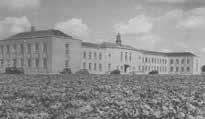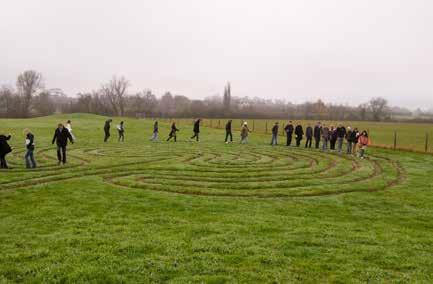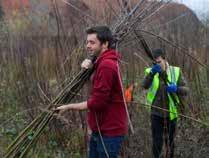
8 minute read
Grounds for education
Writtle School of Design makes use of its campus grounds and plant collections in a cross‑disciplinary approach to learning

Writtle University College’s campus in Chelmsford. © WSD 2019 2. As then ‘Writtle Agricultural College’ during WWII where the front lawn was planted with cabbage as part of the “Dig for victory” campaign
© WSD 2019
The soil, water, and air quality that support our habitats and biodiversity are the fundamental elements of landscape and is foremost in the teaching of students in landscape.
As future landscape professionals, they need to understand and value the ground we stand on and respond to it as designers. The 220 hectares of campus grounds at Writtle University College (WUC), set within an historic landscape, offer great opportunities to understand these fundamental elements and provide a rich and varied facility for teaching and learning. They form an integral part of the methodology of our accredited undergraduate and postgraduate landscape courses, first established in 1995. Writtle School of Design’s (WSD) cross-disciplinary approach to the curriculum reflects the ethos of land-based studies evolving from its inception as a land-based college in 1893, to its university college status today. With a tradition of linking agriculture, horticulture, conservation and landscape architecture, WSD offers a truly grounded and responsive learning experience for future landscape professionals addressing environmental emergency.

As then ‘Writtle Agricultural College’ during WWII where the front lawn was planted with cabbage as part of the “Dig for victory” campaign
© WSD 2019
Located in the outskirts of Chelmsford, Essex, the Writtle campus and wider estate offer a rich variety of historic and contemporary landscape typologies, including woodlands, productive landscapes such as orchards, agricultural land, meadows, together with the riparian habitats of the River Wid, with our own agricultural reservoir and historic moat. Our tree collection and ornamental gardens with agricultural land and conservation areas create not least a wonderful place to study, but a range of biodiverse landscape character types that underpin our approach to learning.
Beneath the ground, historic layers of our past are evident in the moated King John’s Hunting Lodge, and the remains of Roman settlements have been revealed in recent archaeological digs, forming part of the tangible and intangible heritage in the campus landscape. The campus is crossed by public footpaths and linked by cycle routes to a network of parks and river systems to Writtle village and the City of Chelmsford, creating community links and access for members of the public. The grounds function as part of a wider walkable network as well as providing a calm setting for student life and wellbeing.
There are five main soil types across the campus, which traditionally has been used for agricultural food production or horticultural production and ornamental planting. Changes in agricultural policies and approaches to land stewardship have further diversified our approaches to and provided opportunities for developing conservation expertise and sustainable approaches to landscape management. MA students recently undertook a research in their landscape ecology and ecosystem services module where they prepared landscape character analysis reports for the wider campus grounds to mitigate the impacts of flooding of River Wid.
Students are involved with climateresponsive planting in the grounds. In our new management plan for the grounds, there are increased tree plantings to sequester carbon and also to buffer our streams and mitigate noise and particulate pollutants from the road.

Landscape architecture students are preparing the plots on the grounds.
© WSD 2019
The scale of our grounds, range of habitats, land use and approaches to land management offer opportunity, but also competition for resource, and as such provide a living case study in which students can engage.
With its landscape design-based programme, WSD’s approach to learning places a strong emphasis on linking theory to practice. Landscape architecture and garden design theories are applied to both hypothetical and real contexts, and our grounds provide immediate access to a changing landscape for this purpose. Undergraduate landscape architecture students designed the site around the reservoir with a sustainable and climate responsive design approach. Our cross-disciplinary approach benefits learning and is facilitated through our ability to work closely with other disciplines taught at WSD, both in the Sciences and the Arts and Humanities. Our students, for example, benefit from stewarding experimental plots for growing plants in practical and artistic ways, ensuring they have a practical as well of theoretical understanding of plants.
With Arts disciplines, ideas of placemaking, sustainable design and arts- based approaches to design foster a deep understanding of the practical and technical. They are further explored through the making of beautiful ephemeral artwork across the campus. The sciences, too, are explored in the settings of research glasshouses, soil laboratories. MLA first year students have to test the soil in the glasshouses before they start to plan their plots for practice. Our ornamental gardens are developing with a more ecological approach, planting for pollinators and habitat as well as for people and students propagate tender perennial plants and monitor their success over our increasingly mild winters. 6 and 7 . The grounds, therefore, function as a site for learning about land use, landscape and the dynamics of change over time.
Established expertise in land based fields at WUC, such as horticulture and conservation, has enabled the landscape architecture programmes to emerge at Writtle. It is supported by the University’s long established knowledge of soil, drainage and the technical aspects of growing, which form the bedrock of the profession. For example, Year 1 undergraduate students start their practical training with “digging” the grounds to understand the qualities of the soil in their designated plots and learn about the soil structure and the micro ecologies of the landscape through soil tests. The campus grounds at Writtle provide opportunities not only to engage with the practical in-depth knowledge of ecological systems, but also give students a unique opportunity to observe and learn from the dynamic changes and phenomena in the landscape and create public and community arts projects. The public art “Labyrinth project” was a co-production of artist Jim Buchanan and the Writtle students and wider community on the grounds and in the medieval barn in the campus. The project as a learning tool was published as a book chapter by two WSD lecturers in 2016. Through our art and design programmes, science and art are linked through landscape design teaching and learning, where engaging with the public and their responses to landscape interventions and artistic installations can be measured and understood.

Students enjoying the labyrinth in 2006 in a taught session exploring spatial design and again in 2018 where ecological processes are gently changing the profile, form and plant community
© WSD 2019
Students develop a sensitivity to those for whom they might well be designing, as well as learning methods to engage stakeholders in real-life design scenarios. They observe, interpret, respond and reflect through critical analysis and creativity by using art and environmental studies, with installations and interventions within the grounds. WSD has hosted a number of art research projects through collaborations with artists, architects and performers where the grounds have become the setting for artworks, or the soil itself becomes land art, our turf-cut labyrinth being just one example that has persisted and shows change over time. Landscape architecture students learn the basics of topographic surveying on varied undulating parts of the campus grounds and are introduced to the principles of sustainable construction and design using the slopes of the university college reservoir, which was developed in 2001. The reservoir has proved a valuable resource 14 providing an excellent example of successional plant communities. The site links to experimental meadow areas through a series of established hedgerows and remnants of once substantial orchards. The reservoir also provides an opportunity to examine a regraded landscape on typical Essex clay soils and the connection to the campus sites complex hydrological system.
The distinctive regional character of the landscape encompassed by the campus also provides the opportunity for students to learn the principles of Landscape Character Assessment. This includes gently undulating glacial till farmland plateau landscape with the rivers Can and Wid and its relatively large floodplains located in the river valley as one of the three major rivers in the region. It has historic integrity with a strong vernacular such as Writtle village reflecting the regional identity; remnants of medieval originated land use such as ancient woodlands; dispersed hamlets, moats and footpaths surround the WUC campus. Aided by lecture staff and local professionals, students are able to consider scenarios for areas of the campus and develop the skills needed to read a landscape and consider the underlying narrative, whilst developing an understanding of landscape value at a number of levels. The green spaces and water bodies also provide opportunities for capturing the transient phenomena present throughout the seasons and consider the notion of tranquillity and its connection to wellbeing and mindfulness.
Mark Gooding
(MLA, Master in Landscape Architecture, 2nd year student)
More than just reciting Latin names, the outdoor botanical studio is rich in specimen trees and shrubs as well as the extensive glasshouses, stimulating in- depth knowledge. For our construction module, we were given a reservoir to west of the grounds, poorly constructed from an old gravel pit. The project was set around remediating the surrounds and creating an accessible space for ecological education.

Robert Marshall
(MLA, Master in Landscape Architecture, 1st year student)
Just by stepping out of the studio, I can connect with multiple landscape environments. These include new and established gardens in a variety of styles, along with trial meadowland areas, wildlife corridors and WUC’s own reservoir. WUC campus also has an exceptional variety of established plant specimens that help showcase their design merit and application. 16

George Witten
(BSc Landscape Architecture, 3rd year student)
The smell of a border of Sarcococca confusa emitting a strong sweet aroma in spring as you walk by, or the feel of clay as you plunge a boot into deep wet soil in autumn and remove only your bare foot; light permeating through a canopy of birch trees or the atmosphere of a woodland grove. These are all things that can be spoken about in a classroom, but are not the same as experiencing first-hand outdoors. 17

Sharon Chilvers
(BSc Landscape Architecture, 2nd year Student)
I am a mature student at Writtle University College studying Landscape Architecture and use the extensive grounds at Writtle most days in conjunction with my studies, as well as for my own personal learning and understanding. For my assignment in Landscape Perceptions module, I am analysing the historic site ‘King John’s Hunting Lodge’ located within the campus grounds, so I am able to visit the site as many times as I need to.











